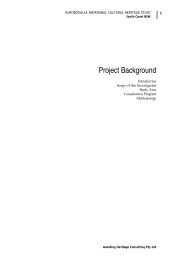Eurobodalla Integrated Water Cycle Management Strategy
Eurobodalla Integrated Water Cycle Management Strategy
Eurobodalla Integrated Water Cycle Management Strategy
Create successful ePaper yourself
Turn your PDF publications into a flip-book with our unique Google optimized e-Paper software.
FACT SHEET 3<br />
Rainwater Tanks<br />
18<br />
<strong>Eurobodalla</strong> <strong>Integrated</strong> <strong>Water</strong> <strong>Cycle</strong> <strong>Management</strong> <strong>Strategy</strong><br />
What are Rainwater Tanks?<br />
Rainwater tanks store rainwater runoff from roofs. Rainwater is funnelled along gutters into<br />
downpipes, which are connected to the tank. In high rainfall areas, it is possible to harvest<br />
considerable amounts of roofwater using rainwater tanks. Rainwater tanks offer an alternative<br />
water supply for use in the home and/or garden.<br />
Rainwater tanks may be used as a separate supply source (not supplemented by town water),<br />
or they can be designed to receive a ‘top up’ of town water. A rainwater tank designed for nonpotable<br />
indoor uses, for example toilet flushing, typically requires a top up system using trickle<br />
feed technology.<br />
Rainwater tanks can form an integrated part of the main water supply system, and be subject<br />
to the same restrictions during drought periods as the reticulated supply.<br />
The recovery of roof water is not only a function of rainfall and tank size, but also a function of<br />
water use. Tanks are more likely to be full during or following wet weather when garden water<br />
needs are low. Connecting tanks to supply water for the toilet and washing machines increases<br />
the utilisation of the rainwater tank and therefore increases<br />
the amount of water tanks can collect every year.<br />
Benefits<br />
Rainwater tanks collect water from the local area, and if<br />
used correctly, are an effective way to take the demand<br />
and pressure off our limited water resources, our rivers<br />
and storage facilities.<br />
Rainwater tanks are able to capture roofwater following<br />
small rainfall events during drought periods.<br />
By storing rainwater runoff from your roof, rainwater tanks can provide a valuable water source<br />
for flushing toilets, in washing machines, watering gardens and washing cars.<br />
Using rainwater for gardens, washing machines or toilets will save money on water bills.<br />
Rainwater tanks improve environmental quality through conserving our valuable drinking water<br />
and reducing the demand on our water supply (conserving water also reduces the chemical<br />
and energy requirements for treating and transporting water to your home via the mains<br />
supply).<br />
Rainwater tanks can help manage stormwater runoff through reducing the amount of<br />
stormwater leaving your property, thereby reducing flooding.<br />
Rainwater tanks promote awareness of water conservation issues through practice.

















